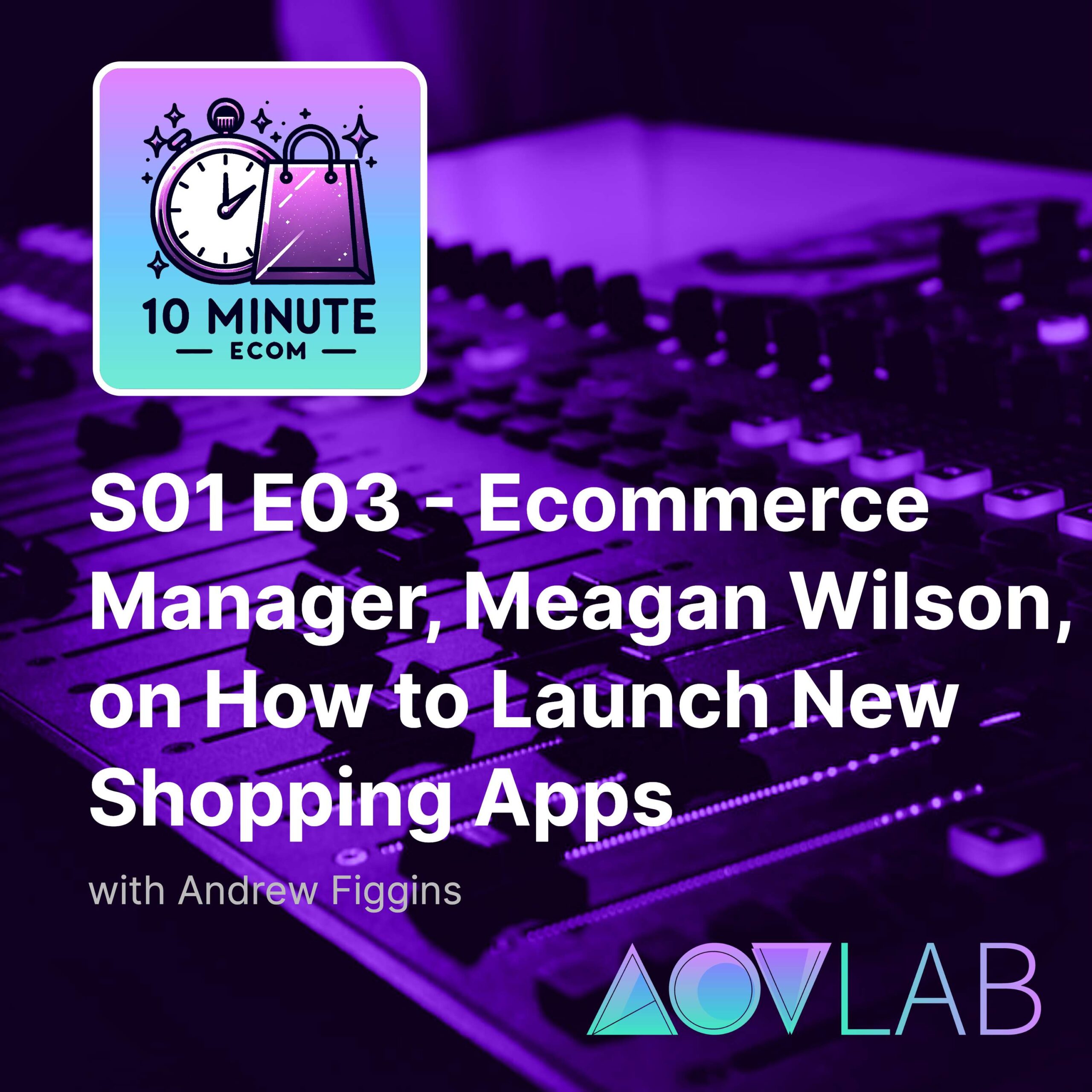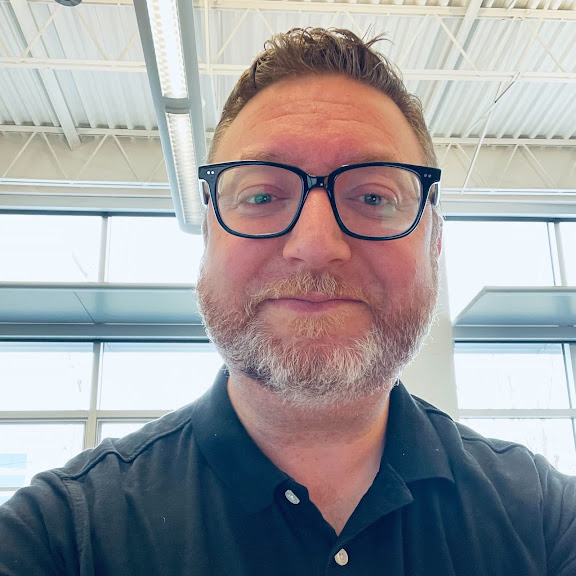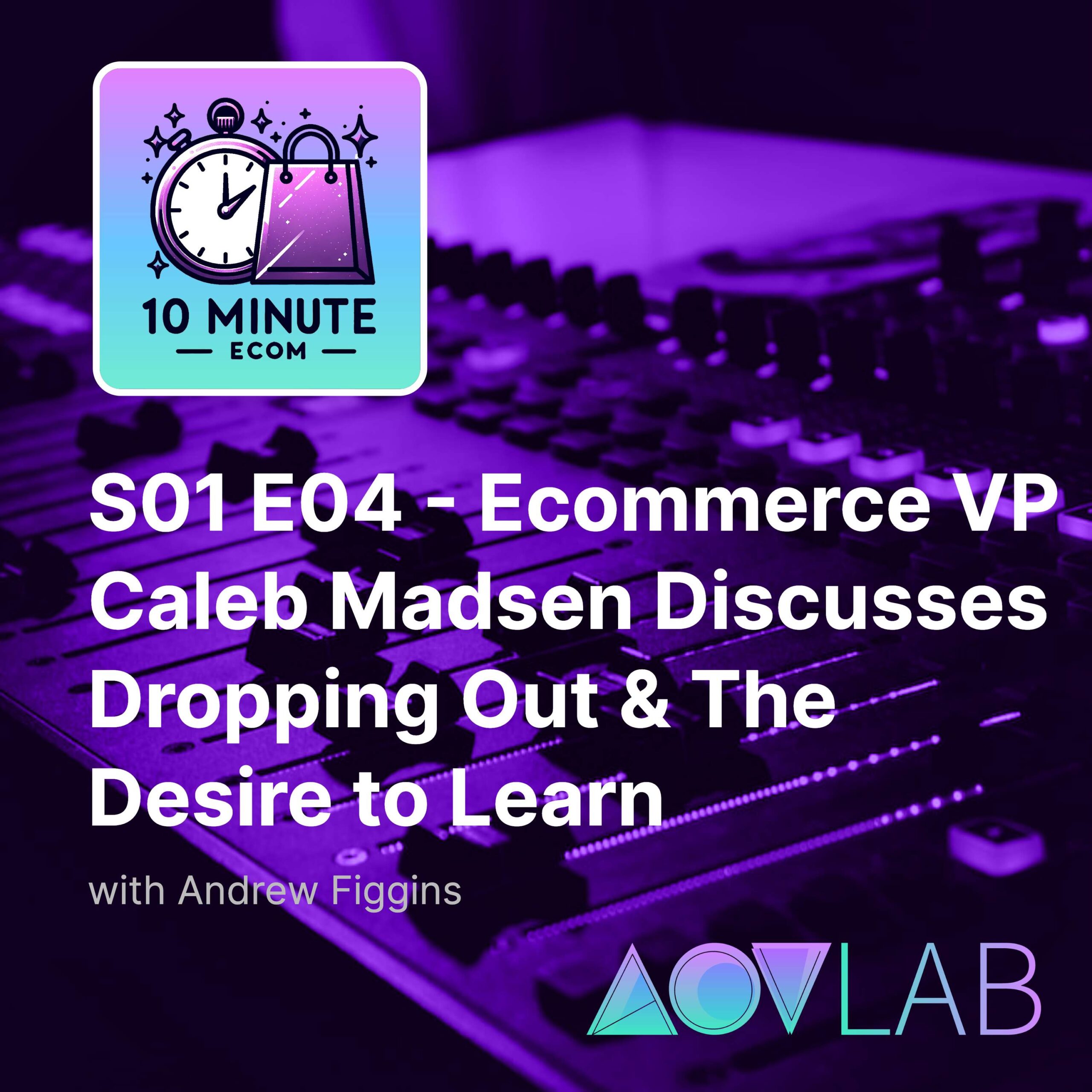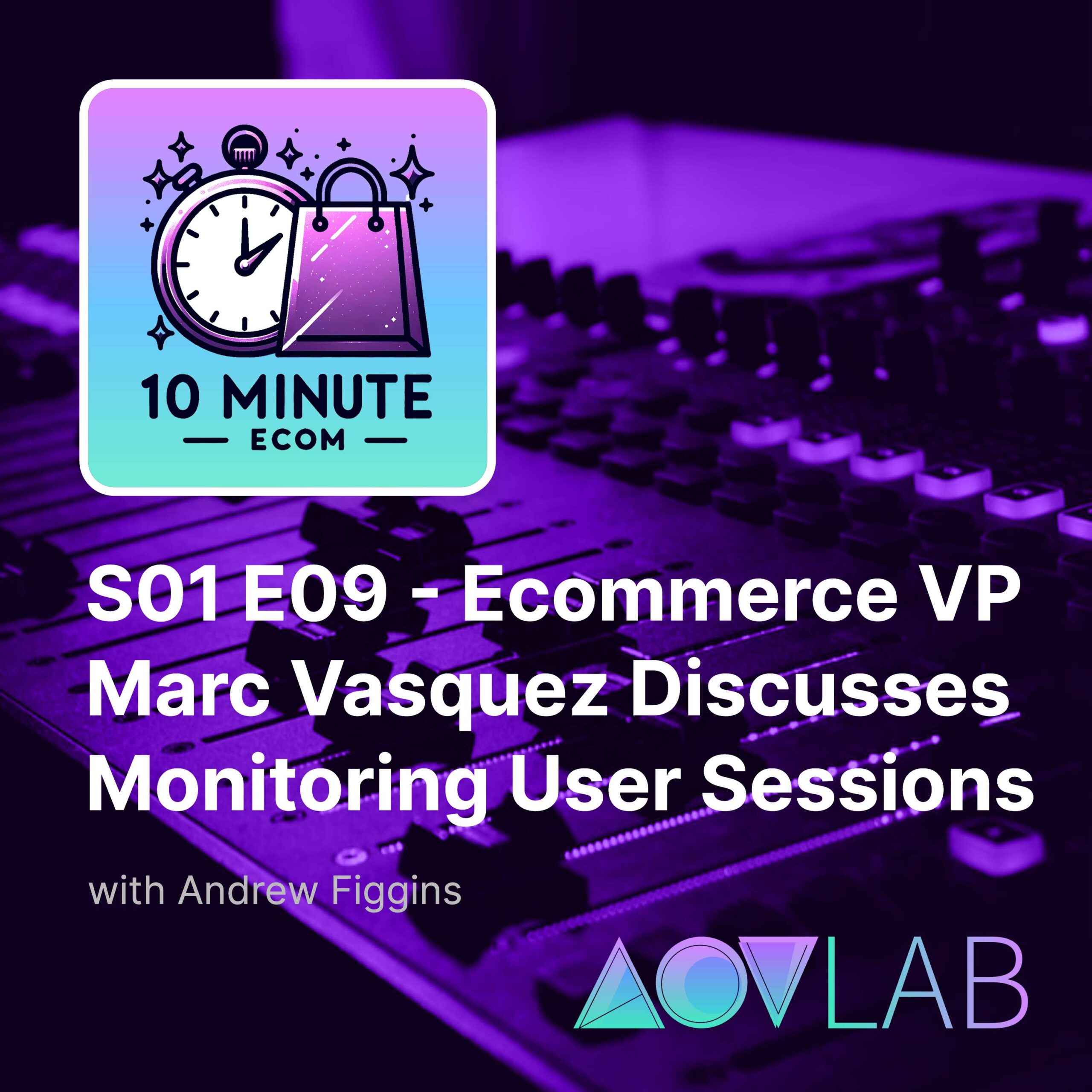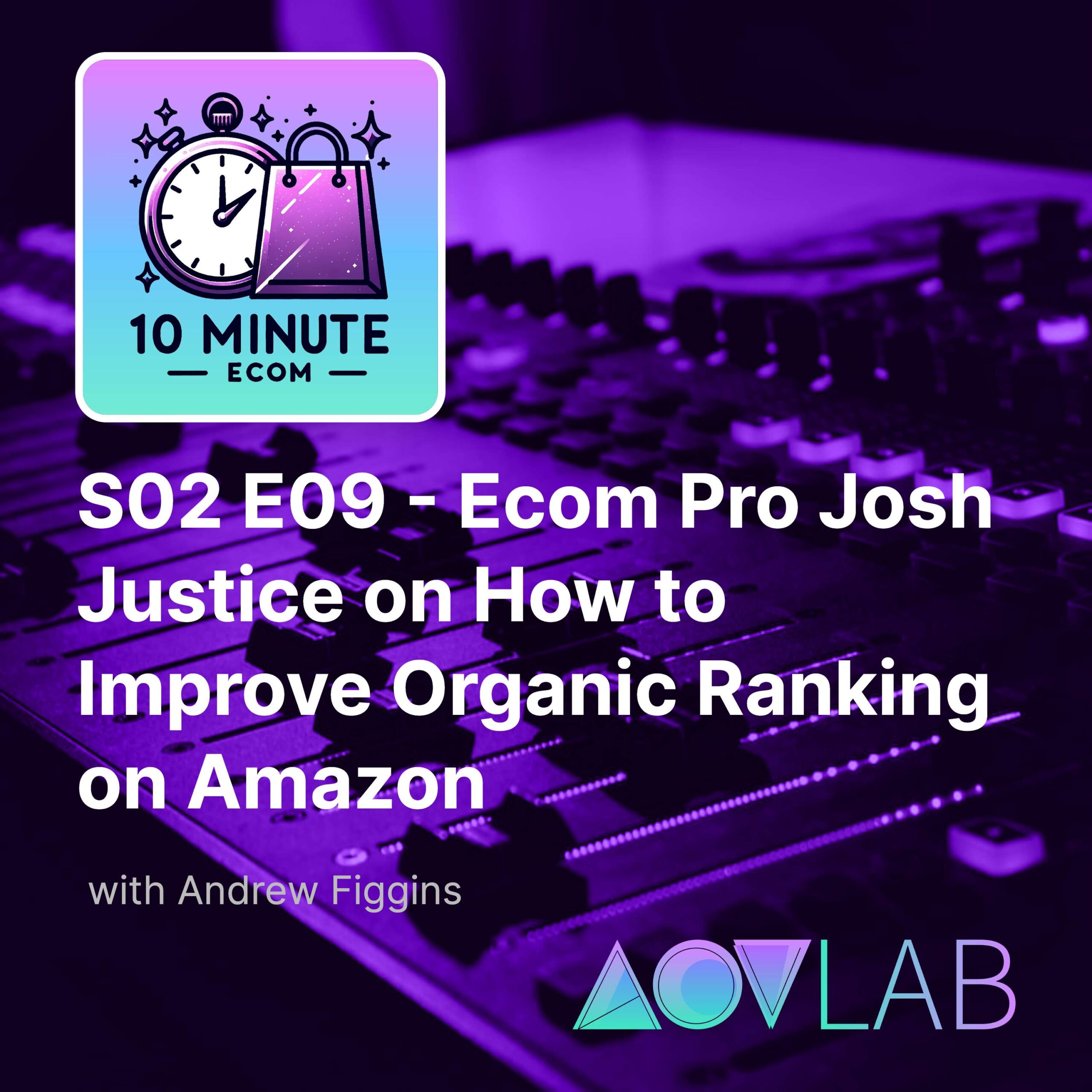Guest: Meagan Wilson, Ecommerce Manager, Alaska Commercial CompanyHost: Andrew Figgins, Founder, AOV Lab Episode Synopsis:Meagan draws upon her recent Ecom experience standing up a mobile shopping app for customers in rural Alaska to convey several tactics that helped her and the team at Alaska Commercial Company achieve success with stores and customers that are using the new apps. Transcript: [00:00:15] Andrew: Hello Ecommerce fans, and welcome to 10-Minute Ecom, an AOV Lab podcast. Every episode, we break down a new and different tactic that can help you improve your ecommerce KPIs (key performance indicators). I’m your host, Andrew Figgins, and […]
View Full Transcript
Episode Transcript
[00:00:15] Andrew: Hello Ecommerce fans, and welcome to 10-Minute Ecom, an AOV Lab podcast. Every episode, we break down a new and different tactic that can help you improve your ecommerce KPIs (key performance indicators). I'm your host, Andrew Figgins, and like most of you, I am an e commerce professional. You may know me as the founder of AOV Lab, the former VP of Digital Product Innovation at Scrubs Beyond, a "guy with a cold," or as the former director of E Commerce Technology at Rural King. Today I'm excited to be talking to Meagan Wilson, an e commerce colleague that is doing incredibly interesting work in e commerce, including launching new e commerce apps for the Alaska Commercial Company.
Just wait to see who Meagan name drops when I ask her about the history of her company. Two great references -- three, actually, including this reference to her reference. And that's an inside joke if you listen to this episode twice.
Anyway, Meagan, what did you come on the show to share today with your e commerce colleagues?
[00:01:15] Meagan: Hi, I'm Meagan Wilson. I'm the ecommerce manager for Alaska Commercial Company, which is based in Anchorage, Alaska.
While working with Alaska Commercial Company, I have stood up a mobile shopping app for customers to order their groceries from Alaska Commercial Company stores. And my primary job now is to manage that app. And we're also working on launching the website version that will be mobile, responsive, but also works very well on a desktop because not all customers in Alaska are mobile first, so would really like to be able to show up on a desktop. So we're working on that.
[00:01:57] Andrew: Thank you, Megan. After the ad, we'll get right into the chat.
Today's episode of 10-Minute Ecom is brought to you by Shopbox AI. I've evaluated hundreds of ecommerce technologies in the last two years, and Shopbox is the very top of my list. They're an award winning Irish team full of innovators that figured out a way to help ecom brands build a store around every customer, which results in five times longer site sessions. That's not a typo or an ad read-mistake-o.
AOV Lab is helping Shopbox break into the North American ecommerce/retail market, and we're happy to arrange an intro and demo so you can see exactly how their addon technology works. To deliver outsized results, go to aovlab.com and click on Vendor Network to set up your 30 minutes discovery call with Shopbox. And now back to the show.
[00:02:56] Andrew: Meagan, I am just going to get out of the way. I'm going to say what everyone listening to this is thinking.Tell us about e commerce in Alaska. Give us the details.
[00:03:04] Meagan: Because Alaska is so unique, I can't talk about ecommerce in Alaska without talking about logistics in Alaska, unlike, say, Instacart, where you can order from your store and then somebody brings it to you in their car. For the most part, our customers who are out in rural Alaska are ordering their groceries from one of our grocery stores that's in what we call a hub. For instance, Gnome Alaska is one of those. And there are many outlying villages, and people will place their online orders through our app. And then that order is picked and packed by a grocery store team, and it goes to the air carrier, which is a regional air carrier, and then they take it to the village, say, teller. So that is a different fulfillment model, really, than you would see almost anywhere in the lower 48. So because of this, prior to being able to order online like that, people would call in those orders and someone at the store would literally write it down on paper, and then they would go and pick the order for the customer. And then they do the same thing. They pack it up very carefully and put it with the air carrier, who would ship it to the customer.
So with the mobile app, what we've done is take that process, put it online with pictures, prices, a full checkout process, everything you would expect if you were, say, shopping in the lower 48. But we've tailored it very much to Alaska. For instance, delivery options are what we call bush delivery, which is where you're ordering from a village, or home delivery, which is local, or curbside pickup, which is pretty standard. But yeah, because again, all of our stores are in rural Alaska, which means for the most part, they're totally disconnected from any kind of interstate road system. They're very self reliant, independent. You have to be pretty hearty.
[00:04:58] Andrew: Well, you absolutely do Megan. And I'll admit that I've never needed to factor "seaplane" into my thinking about the last mile delivery. Which is something that your team obviously does. And that's great. I love the ingenuity. And the initiative that your team. Exhibits in my experience, getting the buy-in and keeping buy-in from stakeholders. Is super critical can never be ignored.
How did you go about establishing that internal buy-in for your mobile shopping at project?
[00:05:28] Meagan: Internal adoption was extremely important for our launch of the new e commerce platform that we were building. We had to gather a lot of buy in from the stakeholders who were basically the store teams. So to do that, we went, myself, my ecommerce team, we would actually physically go to the stores out of Gnome Bethel and Antioch and places like that in Alaska and talk with the store people, get to know them. Find out what their existing processes were filling those call in orders and find out what their concerns were with having that process online because they weren't used to it. And along with launching the mobile app, we also had to launch in the fulfillment side of the system. So we did that, and I started doing that more than a year before we actually ever launched. The system was going and meeting people, learning how they did things, learning what their concerns were. And then we took all of that and built online training programs for them so they could learn step by step how to fill the orders with the online system, the admin panel that we had built. And all of this was custom built for us because Alaska is so unique, we didn't find a platform like, say, Magento that really had everything we needed.
Yeah, we did custom built trainings, we did custom built admin and fulfillment panel, and we did custom built app. And in addition to making sure that we built training and went to the stores, we also presented at our annual managers meeting where all of the store managers come into Anchorage and we have conference. So we had a long well, it felt long because it was three hour and a half long sessions where we talked with all of the store managers for the whole company about what we were doing, the benefits to them, the benefits to their teams, and the benefits to the customers.
And it really did pay off because with a model like that, where you're relying on a store team that you can't necessarily see and talk to all the time somewhere in the middle of Alaska, you really need them to care and have that buy in and connection with the process.
We've gone from basically zero about a year ago last October, we launched the mobile app to I think we're bringing in over 10,000 a week in online orders. And while that number may not sound big, that's zero to something significant in absolutely.
[00:08:09] Andrew: Yeah, I think it's amazing progress. Megan and I'm excited to be chatting with you today about this, your tactic that you're bringing today, driving, ecommerce adoption and a very traditional company. Tell me a little bit about just how traditional Alaska Commercial Company is.
[00:08:29] Meagan: We trace our history all the way back to Catherine the Great and I think her immediate successor, Peter the Great. A charter was granted to I forget the names of the explorers, but basically some explorers went from Russia to Alaska and they met native tribes and they started establishing trading outposts. And naturally, there were various times when the relationship was rocky, but that tradition of having trading outposts in Alaska is the very beginnings of the Alaska Commercial Company. And then later in 1867, with the US. Purchase of Alaska, the handoff was officiated isn't the word I'm looking for overseeing. Overseeing by kind of a third party from what would become the Alaska Commercial Company. And then I think a couple of guys in San Francisco kind of bought the company and it became closer to what it is today. But basically we're looking at somewhere between 300 and 150 years of history of retail grocery in rural Alaska.
[00:09:43] Andrew: Very traditional, to say the very least about it. I have to ask, like, I love the approach that you took and your e commerce team took, which was getting out in the field and basically meeting your fulfillment chain and talking to them and getting them on board with your project. What was sort of the impetus to doing it that way? Had you all tried a different way in the past and seen things not work? Or was that something that you brought to the mix or how did that sort of come about?
[00:10:15] Meagan: When I joined the company, the idea was that we were only about three months from launching the app. As I got into the project, I realized and, you know, kind of all of us who were involved realized that was not really the case. The timeline was further out, as is often the case with technology projects, but from the very beginning, everyone else who was involved, who'd been in the company for 20 or 30 years, was very aware that it's a hands on relationship building because it's traditional grocery. In my first week, my boss had me going out to stores I visited. Nomencview, I think the very first week, that whole maybe the second week, it's kind of part of our company culture already to do that and to be that way. The challenge for me was partly like, because my background is more ecom and not traditional grocery, I had to come in and crew Alaskanus, if you will. So it was very important for me to go in and build those relationships and to show the store teams that we're going to build something that's easy to use. We're not trying to make your job harder. We're trying to make it easier and save you time and effort.
[00:11:26] Andrew: Yeah, that was why that makes sense. And it seemed like it was an opportunity where the stores probably had some processes in place previously, not for digital orders, but just for orders that were being phoned in by customers. How did the digitization, if I could say that with a cold, that's a hard word to say.
[00:11:48] Meagan: With a cold, that's a hard word.
[00:11:50] Andrew: But how did your team start to digitize some processes? And how did you go from probably a very paper based process, I have to guess, to hopefully something that might be a mix of paper based and digital or all digital.
[00:12:06] Meagan: You're right. It is a mix. So we're in still an ongoing transition. The stores that already got the bulk of those bush orders, the call in orders to be shipped to a village, we made sure to visit them the most. And during the process of talking with them and figuring out how they already were doing things, we decided that what we should do is furnish them with tablets that would have the picking.
It's not a picking app. It's actually a site. But anyway, the admin site where they could pick the orders on the tablet, and that way they can take that tablet around with them as they pick the orders and mark off, okay, this one's picked, this one was unavailable, so on and so forth. And that makes what would have been a paper based list more digital and quick for them. And then some of our other stores that hardly get those online orders, they still print the order details, and then they fill it on paper, and then they go back to the site and fill it in online.
As the business grows, that part of the business and they get more orders, then we'll start providing those tablets to more stores because it is quicker.
But yeah, it's a process of, like you said, transitioning from very much paper to digital.
[00:13:30] Andrew: And it sounds like your team has been sort of central, helping both the executive team understand this new digital landscape, but also the folks on the ground, the folks in the stores transition as well to more of a digital landscape and way of doing things. How do you approach that in terms of we're dealing with technology here. We're dealing with a mobile app, a website. It sounds like soon that's going to have a great shopping experience on it for your customers.
How do you go about talking about these things that are technical and maybe complex to folks that maybe just aren't ecommerce minded or technical?
[00:14:14] Meagan: Any communication is a process of learning about your audience and then encoding your message for them and then sending the message. And then the final step, which is easy to miss, is finding out whether the message was actually received, getting that feedback, and then re encoding the message. So over the last two and a half years, it's been a constant process of figuring out, okay, what makes sense to my audiences? How do I encode this in plain language so something really simple. Not everyone actually knows what the term ecommerce means. So a lot of the time I will say online shopping or ordering online to get your groceries, something very non, which seems to help the team in the office in Anchorage. They understand that a little bit more, but for them it's been more a process of learning their existing retail merchandising processes and how they already input, say, product data and then making sure that gets translated correctly into the ecommerce platform. So with them, it's more talking about product data, talking about fulfillment methods, supply, things like that. But for the store teams and when I talk with customers in the stores, it's very much more like online ordering, ordering groceries, not so much ecommerce terms.
[00:15:52] Andrew: Got you. I'm guessing it's been positive. But what's some of the feedback that you've gotten from customers since launching the new mobile app?
[00:16:02] Meagan: Customers seem pretty happy. They enjoy being able to see the pictures and decide what they want. Instead of having to call and say, for instance, I would like some rice, and then go through a whole conversation with the person in the store about what kinds of rice are available, what sizes of rice are available. There are still people who prefer that that call with the store might be an important part of their social world. I don't think we'll ever have 100% adoption, though. That would be wonderful. But yeah, the people who order often, and we have a lot of people who have now put in 2030 orders over time, they seem to really like that. It's fairly easy to do, and they can still have a touch with the store if they need to, can still call the store if they need to. And we also have, of course, ticketing system built into the app. So if they need to ask a question or they need to put in a refund request, they can do all that in the app too.
And then you didn't really ask me this, but stores, they will definitely tell me, hey, this thing isn't working, or can you please tweak this? But the other day, I was walking one of the store managers through picking an order, and she hadn't used that system yet, and she said, oh, you made it so easy. This is so simple. I love it. That was just the best thing, because we really tried.
[00:17:22] Andrew: That's great. I think there's nothing better in ecommerce than either having one of those conversations with someone you're serving, whether it's a customer or somebody in a store, and getting some feedback like that, oh, you guys made it easy. You made it in one click or one tap. It's always a good thing. Megan, I think it's so fascinating what you're doing for Alaska Commercial Company. I want to thank you again for coming on the show. Like, we barely scratched the surface here, but it is ten minute ecom. We don't have a whole lot of time. I wanted to ask you, though, before we depart here today for your colleagues in Ecommerce that are thinking about starting something new, developing a mobile app for ordering what's? Some advice that you might have for them.
[00:18:07] Meagan: I think two or three things. So, thing number one, ecommerce is such a large field, it's basically impossible to be an expert in all aspects of it. So make sure you gather a strong team around you, whether that means that you can actually hire staff, and if you can, great. Or you need to pick the brains of people you know who are already in ecom or pick the brains of people on LinkedIn. Make sure that you get as many aspects of it and as many subject matter, as much advice from subject matter experts as you can. Don't assume based on your own so I guess thing number two is don't assume based on your own experience that you know what your users are going to need. There's a lot of data about what users need. Dig into it, because each of us tends to be very biased. And if you're already in technology, you're probably a lot more advanced than your average user in that way. Don't just think, this is how I would do it. So that's what they want. And then the third thing is probably it's the same as number one, but don't lose heart. It's always a challenge, and any technology launch can often run away with the timelines. Yeah, keep your chin up.
[00:19:27] Andrew: Outstanding. Thanks again, Megan, for coming on the show today. I think you brought some Alaskan-ness to the show that we very much needed today. So thanks again.
[00:19:37] Meagan: Thanks for having me. It was fun.
[00:19:39] Andrew: So that's a wrap for today's episode. I want to again thank our guest, Megan Wilson. If you have a moment, be sure to subscribe or follow the show on Apple podcasts, Spotify, Amazon Music, Google Podcasts, or wherever it is that you listen.
If you have a topic, suggestion, or if you're an e commerce professional that would like to join for an upcoming episode, reach out to [email protected], and a human with a cold will read and respond to your inquiry. I hope you're enjoying these first episodes of the show. I know I sure am. It's been a pleasure to talk to my ecommerce colleagues a couple times a week. And that is the release plan. Throughout the end of the year, every Tuesday and Thursday, a new episode of 10-Minute Ecom will go live. I'm signing off. Until next time, this is Andrew Figgins. Have a good one.
